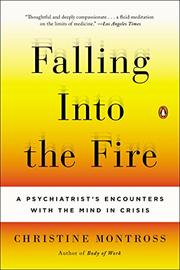Note: I received a copy of Falling into the Fire from the publisher in exchange for an honest review.
In her review of Falling into the Fire earlier this year, Victoria said “I begin to wonder whether there is an entry in the DSM (the Diagnostic and Statistical Manual of Mental Disorders) for readers like me, who find themselves fascinated by accounts of people struggling with the different illnesses it defines.” If there is, I surely have it, and I could not resist asking Penguin for a copy of this psychiatrist’s account of some of her most severely ill patients at the hospital psych ward. Montross writes about Colin, who believes he has experienced a spiritual awakening and is unnerving his friends and relations; Lauren, a regular of the psych emergency room, who swallows scissors, needles, anything she can get her hands on; and many other patients who have challenged Montross and aroused her interest and sympathy.
In each chapter, Montross begins by talking about a patient and the symptoms that patient presents, and then she moves on to write about the history of this type of illness: What we know about it, and what we absolutely don’t. For instance, she brings up the case of body integrity identity disorder (BIID), whose sufferers believe that they are intended to be amputees, that certain parts of their body do not belong to them. They go to extreme measures to amputate the offending portion of their bodies, and after they’ve managed this, they are better. Cured. Montross cites a study suggesting that the parietal lobes of BIID sufferers may not be recognizing the legs (or hand, or whatever body part the sufferer doesn’t want to keep) as a part of the coherent human body. But she also notes that we don’t know enough yet about this to draw any definitive conclusions. If the cure is to amputate the legs, should we? Surely we can’t amputate healthy legs, but then — what if that is legitimately the only way to end this kind of mental torment?
This leads me to something I really liked about the book: Montross doesn’t shy away from talking about the uncertainty of her work. So much of what we think we know about mental illness and the practice of psychiatry is uncertain and subject to change. Brains are not hearts. Our understanding of them is woefully imperfect, and when there’s something wrong with the functioning of a brain, we’re floundering around in the dark a lot of the time. Montross knows this. Even when her patients improve drastically, she acknowledges that she hasn’t sent them home cured. She thinks about them after they leave, wondering what their futures will hold, if they’ll suffer a relapse, if she made a mistake sending them home when she did, if she should have kept them longer and given them different treatment.
Less interesting are the memoirish portions that appear at the end of each chapter. Montross is tying her patients’ lives into her own: a mother who admits herself to the hospital with the fear that she’ll harm her baby reminds Montross of thoughts she had as a new mother that she might drop her baby into the river and lose her forever. Occasionally (as in the foregoing example), this sheds light on how thin the line is between normalcy and dysfunction, but more often it feels unnecessarily self-indulgent.If you’re a fan of psychiatric case studies (which I could read until my eyes fall out of my skull), Falling into the Fire is a lovely, thoughtful, compassionate collection of them. Recommended.


Cover report: British cover wins. Neither one is blowing my mind.